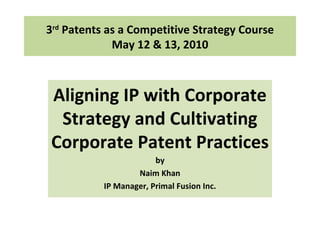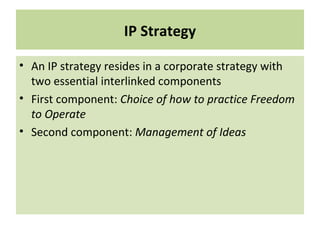Aligning Intellectual Property with Corporate Strategy and Cultivating Corporate Patent Practices
- 1. 3 rd Patents as a Competitive Strategy Course May 12 & 13, 2010 Aligning IP with Corporate Strategy and Cultivating Corporate Patent Practices by Naim Khan IP Manager, Primal Fusion Inc.
- 2. Screening Corporate Objectives: Defining and Incorporating IP Objectives Every Contemporary Business Strategy has IP in it. Here is the reason why. A business strategy is designed to avoid risks and reap rewards. An IP strategy manages risks and rewards for a business. An IP strategy does not automatically mean filing of a patent You need freedom to operate to launch your products or services or even just to adopt a name You should not take a risk without having at least a basic freedom to operate knowledge
- 3. IP Strategy An IP strategy resides in a corporate strategy with two essential interlinked components First component: Choice of how to practice Freedom to Operate Second component: Management of Ideas
- 4. Incorporating Freedom to Operate "Freedom to operate" is usually used to mean determining whether a particular action, such as testing or commercializing a product, can be done without infringing valid intellectual property rights of others
- 5. Incorporating Freedom to Operate What choices do you have? Freedom to operate gives businesses the latitude to execute their product or service strategy without the fear of competition An open freedom to operate: Possible in mature technologies; High legal and financial risk in new technologies An exclusive freedom to operate: File patent, acquire patent or acquire an exclusive license; Low risk and potentially high reward A shared freedom to operate: Acquire a non-exclusive license; Low risk and medium to low reward Generate freedom to operate: License your patented technology ; Low risk and high to low reward
- 6. The Most Important Resource of a Company Ideas Ideas are needed for competitive advantage Ideas can always be generated If you buy a company stock you are likely to buy it for the innovation and technology the company owns The ownership gives the company freedom to operate and adds value to a company Ideas no longer come only from the research an development activity Ideas can be related to any valued activity
- 7. Management of Ideas Start an IP project for an idea Recording and Documentation (Technical & Legal) Evaluating novelty (Technical & Legal) Evaluating completeness: Is the idea workable (Technical) Evaluating value proposition: how the idea is connected to your business and product strategy (Technical & Marketing and Sales) Validating novelty (Legal)
- 8. Management of Ideas Identify deliverable and alternate paths to deliverable (Technical & Legal) Evaluate competing technologies and competitors (Technical & Legal) Evaluate future modifications (Technical) Evaluate markets: financial (Marketing and Sales) Evaluate markets: geographical (Technical, Marketing and Sales & Legal)
- 9. Management of Ideas Evaluate budget to file patent (Legal & Finance) Determine availability of budget and track yearly budget (Finance) Determine your choice of freedom to operate (Executive) You may still have to file for a patent (Legal) If you patent, ensure that the invention is legally owned by the company (Legal)
- 10. Outcome of Execution of IP Strategy Patenting activity is an outcome of a business process Lowered cost across the board for IP activity Justified IP spending Informed understanding of your business, future vision and competition Acquire Not just Freedom to Operate but Freedom to Plan, Execute and Reshape Vision Intangible now feels tangible YOUR IP IS ALIGNED TO YOUR BUSINESS GOALS
- 11. Feedback and Communication Management of ideas involves all departments: Legal, Technical, Marketing, Financial and Executive Management They are delivering their required input Need to stress the importance of an IP project as a mission critical project Assemble a team from all business units Have all departments present their reports in team meetings Present final report in a team meeting along with executive management
- 12. Raising Patent Awareness Include an IP role in an employee responsibility Give incentives for novel idea generation Give incentives to managers for collecting new ideas Arrange targeted brainstorming sessions to generate ideas Require all members to periodically attend IP seminars Communicate an estimate of IP related profits to all
- 13. Technology Map Life saver Three components and many derivatives Inventory of ideas Global market survey IP survey
- 14. Technology Map Inventory of ideas Collect all ideas Do not discard any idea initially Connect ideas to existing products or services Connect ideas to future Invent upon ideas See the complete picture
- 15. Technology Map Global Market Survey Identify the ecosystem in which your company exists Identify broad components of the ecosystem Collect statistical and financial data to see what the market is saying See the underlying trends unfolding in the ecosystem Collect information on all relevant M&A activity and with IP details on patent evaluation, licensing and the synergy between merging companies Write down key questions to answer
- 16. Technology Map IP Survey Identify competing companies Identify their IP Bridge their IP to their published strategy and products Identify the risk from competition Identify patent prior art Identify non-patent literature Identify key researchers and clusters Identify relevant court decisions
- 17. Technology Map Connect all components of Technology Map Observe the intersections Document and Answer key questions Present findings to upper management Use Technology Map extensively in management of ideas process Update continuously Guide Business Strategy and IP Strategy from your observations Shrink delay of time to market
- 18. Anticipate the Future IP strategy today is about carving your space in future Do not miss the boat by not examining what is in front of you Evaluate your ideas Best way to see the future is to invent it


















